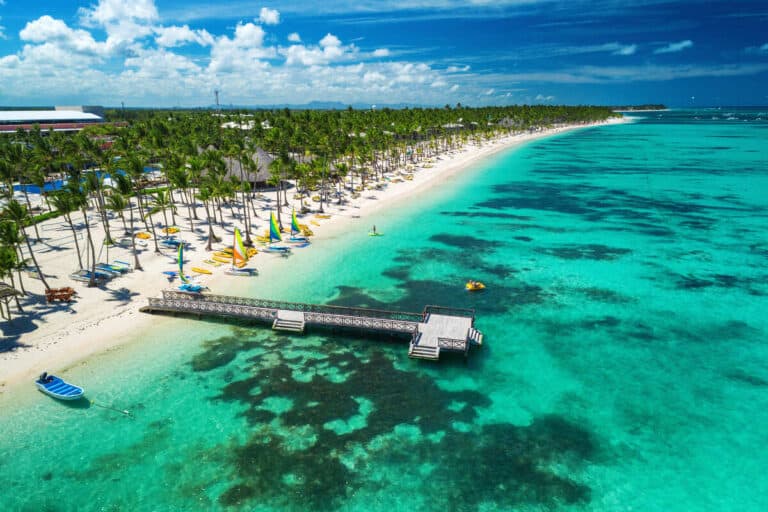If you’ve been following the news recently, you may be wondering how safe the Dominican Republic is to visit right now, considering the full-blown crisis in neighboring Haiti, a severely underdeveloped country now run by militia groups and where violence is rampant.
As reported previously, Haiti is now one of the most dangerous places to be, with gangs having laid siege to the capital, criminals running amok, and multiple countries urging their citizens to leave Haitian territory due to the deteriorating situation (the U.S. included).
Seeing that the Dominican Republic (DR) shares the same island as Haiti, how actually safe is the popular Caribbean resort, and most importantly, is it being affected at all?
How Is The Haiti Situation Affecting The Dominican Republic?
The short answer is, yes, the DR is still safe, or as safe as it can be, particularly the incredibly popular resort zones in Punta Cana, La Romana, and Puerto Plata, which have been visited by Americans for years and continue leading booking trends across the islands.
That being said, it’s inevitable that, as Haiti’s only neighbor, the DR would be affected, at least to a lesser extent, even though the ramifications of the Haitian crisis will not necessarily impact tourists in Punta Cana.

It may sound confusing at first, but allow us to explain:
In case you’ve never given Caribbean geography too much thought, you probably don’t know the Dominican Republic is not its own island: though it is on an island, the beautiful Hispaniola, it shares it with another independent state – Haiti.
While French-speaking Haiti occupies the western end of Hispaniola, the DR controls the eastern half, where all the luxurious resorts and best-developed beach zones are centered.
The DR is no developed country, being plagued by poverty and higher crime rates per capita than the U.S. or Canada, but compared to war-torn Haiti, it might as well be Switzerland, as the government retains sovereignty over the territory, and law enforcement is arguably more effective.

The same cannot be said of Haiti, where top-ranking officials are persecuted and threatened on the daily, and civilians live in a constant state of fear; let’s just put it this way: the DR is no safe haven, but it is far from being a failed state where public calamities are unfolding.
How Is The DR Protecting Itself From The Crisis?
Following the souring of relations between DR and Haiti, and the crisis in the latter, it was expected that the violence would spill over the border into the much more peaceful Dominican Republic, however, as of March 2024, that is yet to materialize.

Despite the latest surge in refugee numbers, Dominican Republic authorities have been adamant their land border must be reinforced, with Foreign Minister Roberto Álvarez Gil treating the ongoing situation in Haiti as a major security threat.
Among the safety measures imposed, a 12-foot-tall borde fence has been erected to protect the DR from Haitian gangs and the influx of migrants, accompanied by watch towers, surveillance drones, and cameras.

Controversial as it may be, DR officials have also been firm in their message to fleeing Haitians, stating there are ‘no refugee camps’ in the country, and implying those who somehow manage to get past the ‘wall’ will be unceremoniously deported back.
The strict anti-migrant policy has drawn the attention of Elon Musk himself, who responded with an enigmatic ‘interesting’ to a Twitter post criticizing Joe Biden for not adopting the same hard-lined policies at the southern U.S. border.
Interesting https://t.co/XCiS3x4Cjy
— Elon Musk (@elonmusk) March 19, 2024
DR President Luis Abinader was quick to engage with Musk, reiterating the so-called Smart Security Fence Initiative is ‘indeed an interesting project’, and inviting the billionaire tech mogul to visit the Dominican Republic to ‘see it for himself’ and further ‘explore potential opportunities’.
Thanks to the rapid, effective response on the DR’s part, and their strict border policy, the country has been largely shielded from any Haiti-related ripple effects.
How Safe Is Punta Cana Specifically?

At this point, you’re probably thinking: what about Punta Cana specifically? How is the resort city managing the crisis, and should visitors be concerned?
Welcome back to Geography 101: if you need some help pinpointing Punta Cana on a map of the Dominican Republic, consider adding 282 miles between the tropical beach spot and the nearest border crossing.
In other words, it could not be geographically further away from the Haitian mess, as it sits roughly on the easternmost edge of the Dominican Republic, and thus of Hispaniola island: if there’s one town that’s remained completely undisturbed, it’s Punta Cana.

Similarly, every other major tourist destination in the Dominican Republic has stayed oblivious to the crisis, as the government’s stellar job at ensuring violence stays on the western side of the border has allowed tourism to go on as usual.
Americans Should Still Be Careful Visiting The Dominican Republic
Now you know: the Dominican Republic can take care of itself, but this does not mean it is exactly crime-free.
It may have warded off Haitian gangs, but it has its own share of domestic problems to tackle, from drug trafficking to violence in suburban zones.

The United States maintains that the Dominican Republic is moderately safe, but it does urge Americans to exercise increased caution when visiting, as violent crime, including armed robbery, is a common issue across the territory.
Resort cities like Punta Cana and La Romana are a lot safer, and if you’re staying in an all-inclusive resort, you truly have nothing to worry about unless you’re going on an outing.
In that case, you should be aware of your surroundings and follow general safety advice.
This includes not displaying signs of wealth – a.k.a leave your expensive Rolex tucked away in a safe – and adhering to guidelines set out by resort and tour operators, as they do know best.
Credit: Source link

